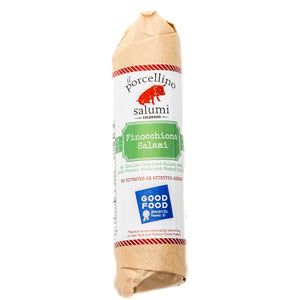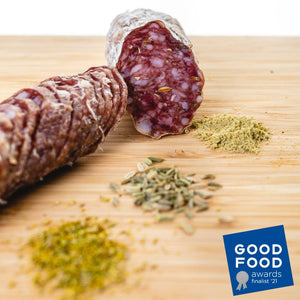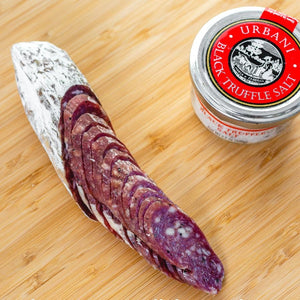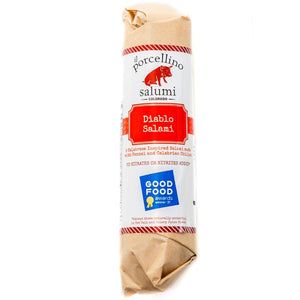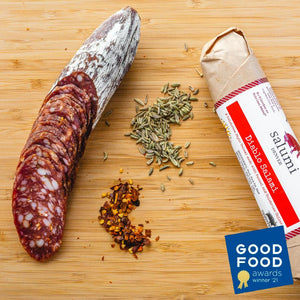Bacon is arguably the most well-known pork product in America. I can smell it and hear it sizzle just by saying the word bacon. My head fills with the annoying boisterous voice from the dog treat Beggin Strips ads when I say bacon. From ice cream flavored bacon to chocolate-covered bacon, it's incredibly popular and rightfully so.
Generally, bacon has a sweet, smoky, and salty flavor rounded out with unctuous notes from the fatty pork belly muscle. The taste can vary depending on the pig breed, what the pig eats, ingredients used, curing methods, and what type of smoking wood is used. Overall, bacon's core flavor profile is what sets it apart. It can be used in almost any dish, from healthy vegetable dishes to bacon candy lollipops.
I'll give you the lowdown on bacon, how it's made, ways to cook it, and how we make our Peach Wood Smoked Bacon.
What is Bacon and Where Does it Come From?
Bacon comes from pigs and is a type of salt-cured pork cut.
You read that right. Real bacon comes from a pig. Turkey, duck, vegan, and other non-pig bacon substitutes can take a back seat. Though, I recommend trying different types. Duck bacon, or what we like to call “Quack Bacon”, is delicious!
Also, unlike other pork products, bacon isn't defined as a specific cut of meat from the pig. What makes it bacon is that it came from a pig and went through a curing process.
Let's discuss American bacon or what folks overseas call "streaky" bacon. American bacon also called side bacon, is cut from pork belly. This is the bacon that comes in sliced strips and is available at the grocery store. It's fatty and has layers of fat that run the cut's length.

The image below shows half a pig being processed into several cuts. The center section contains the loin, ribs, and belly.

First, the loin is separated from the belly & ribs.

Then the ribs are removed from the belly.

The remaining cut is the pork belly which is cleaned, cured, and smoked to make bacon.

You might be able to buy the pork belly from your local butcher to cure and smoke your own bacon. You can also buy "slab bacon," an unsliced cured pork belly. The nice thing about slab bacon is you can cut your bacon slices as thick as you want.
Now English bacon and Canadian bacon are cut from the loin and tend to be leaner. The loin is near a pig's back, so this bacon type is often called back bacon and resembles ham more than American bacon. Though, English bacon is usually cut from the loin in a way that leaves more fat around the meat than Canadian bacon.

What Makes Bacon, Bacon? Curing & Smoking
I'm sure you know this, but curing developed as a way to preserve meat before refrigeration was invented. From my understanding, there are still debates about which ancient civilization created curing, but it's safe to say that it's an old process. Curing isn't necessary for preservation anymore, but it provides exceptional flavor.
Curing is a necessary step in making bacon and one that packs the meat with flavor.
Dry curing is the traditional method for curing bacon. The raw bacon is rubbed with salt, seasonings, sometimes sugar, and nitrates, giving it flavor and activating the curing process. Then the meat is left to cure for one to two weeks.

Dry curing has been time-tested and provides a robust flavor, but it's more time-consuming. It's an artisanal process, and dry-cured bacon usually costs more.
Wet curing is how most bacon is cured in the modern era since it's quicker and more profitable for large producers. Salt, seasonings, sometimes sugar, nitrates, and water are mixed to create a curing brine. The raw bacon is soaked in the brine or, more commonly, injected with the brine. The bacon usually soaks or hangs injected with the brine for a few days or up to a week, depending on the strength of the brine, so the flavor develops.

After curing through the dry or wet process, bacon is smoked, typically. Smoking the bacon preserves it further and adds flavor. Smoking is usually done at low heat for enough time to flavor the bacon without cooking it.
Different types of wood chips will add a specific flavor. You'll often see bacon smoked with applewood, hickory, or cherry wood chips, but other flavors can be used. Some producers inject their bacon with liquid smoke to quickly achieve the smoky flavor. Liquid smoke is generally used in mass production to speed up the process.

You can buy unsmoked bacon too. Smoking bacon is not necessary for its production process and isn't needed to make it cured.
Cured vs. Uncured Bacon. What’s the difference?
Nothing. Cured and uncured bacon are the same thing. We discussed this in another blog post about cured meat, but we'll quickly run through it.
Uncured bacon uses ingredients with natural sources of nitrates to cure it, and cured bacon uses synthetically made nitrates and nitrites. The USDA requires that "cured" be defined by using sodium or potassium salts of nitrate and nitrite because they're easier to regulate. Uncured bacon uses products with naturally occurring nitrates like celery powder to cure it.
Cured and uncured bacon both use nitrates and nitrites to get the end product. The only difference is whether the nitrates and nitrites are naturally occurring or human-made.
Blame the USDA for the current confusion.
However, there is a push to clarify the cured and uncured confusion on product labeling. By 2023 the word “uncured” will go away, maybe sooner, we’ll see. Phrases such as “Naturally Cured” or “Made with No Artificial Nitrates” will start appearing on labels in place of “uncured.” This will clarify whether products use natural or artificial nitrates and nitrites.
Cooking Bacon
The ultimate goal is to render the fat evenly to get a crispy texture without burning the bacon. Some people might debate whether chewy bacon is better than crispy bacon, but I don't have time for that.
-
Skillet: The classic way to cook bacon. I recommend letting the bacon come to room temperature or pretty close before cooking it. Put the pan on medium heat and add the bacon right away, so it comes to temperature as the pan heats up. Don't preheat the pan. Turn the bacon as needed and cook for about 10 minutes. Drain the bacon on a paper towel or pat the strips dry before serving.

-
Oven: Cooking bacon in the oven is great for large batches and avoids oil splatter on the range top. It is my absolute favorite way to cook bacon, as I feel perfect doneness can be achieved this way, with better heat control. I like to say low and slow in the oven provides the best results! Using a baking sheet, line it with parchment paper, and put the bacon on it. Cook it at 275 degrees Fahrenheit for 30 - 35 minutes or until preferred crispiness. Once out of the oven, drain the bacon on a paper towel or pat the strips dry before serving and enjoy!

-
Microwave: This is my least favorite process, but it works, especially in a pinch. The bacon tastes the same, but it feels wrong to cook bacon in the microwave. Line the microwave or a microwavable plate with several layers of paper towel. Place the bacon strips on the paper towel without overlapping and cover the strips with a paper towel layer. Cook on high for four to six minutes and add more time if needed. You shouldn't need to drain the fat since the paper towel usually soaks it up while cooking. You can buy microwaveable bacon cooking trays designed for this process.
Is Pancetta Bacon?
Technically, yes, pancetta is a type of Italian style bacon. Pancetta is cut from the same part of the pig as bacon. The main difference is that pancetta is cured longer, with more spices and aromatics, so that it can be eaten uncooked or cooked. Plus, Pancetta isn't smoked. Although bacon has been smoked, it is technically still raw and needs to be cooked before eaten.

il porcellino salumi’s Peach Wood Smoked Bacon
As you can imagine, we take our bacon pretty seriously. Like all our products, we don't cut corners, and our bacon is no exception. Our sandwich, "The Bacon," has been recognized by publications including Food & Wine Magazine and Westword Magazine with our Westword Best Sandwich Shop Award. You'll find our bacon on several of our deli menu items.

I've spent a lot of time perfecting this recipe, and I can't wait to share it with you! Currently, our bacon is available at our retail store in Denver and through Italco Food Products in Colorado and New Mexico. You'll find it at Rocky Mountain Whole Foods stores in late spring or early summer 2021.
If you are a restaurant or retail store in the area, contact your Italco Foods representative or us for wholesale.

We make our Peach Wood Smoked Bacon with Berkshire pigs from Red Top Farms. Red Top Farms is a co-op of farms in the Upper Midwest that raise hogs on pasture, with vegetarian diets and no antibiotics or growth hormones.
We rub it with a proprietary blend of sea salt, brown sugar, maple sugar, celery powder, herbs & spices. After the bacon cures, it's rinsed and moved into the smokehouses for a healthy dose of heat from Colorado Peach Wood. We smoke it low and slow until it reaches an internal temperature of 150 degrees.
Once cooled down properly, it heads to the slicing machines, and then it's packaged. Every pork belly is given 110% of love from our hands to your plate. Our process is handcrafted, artisanal, small-batch bacon at its finest.


